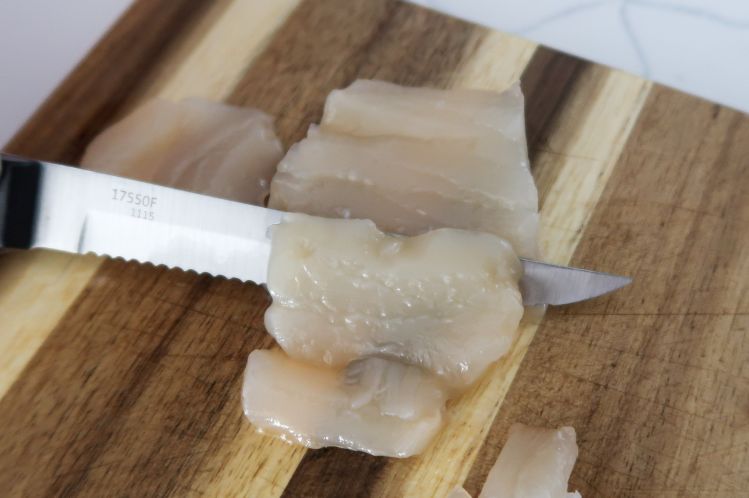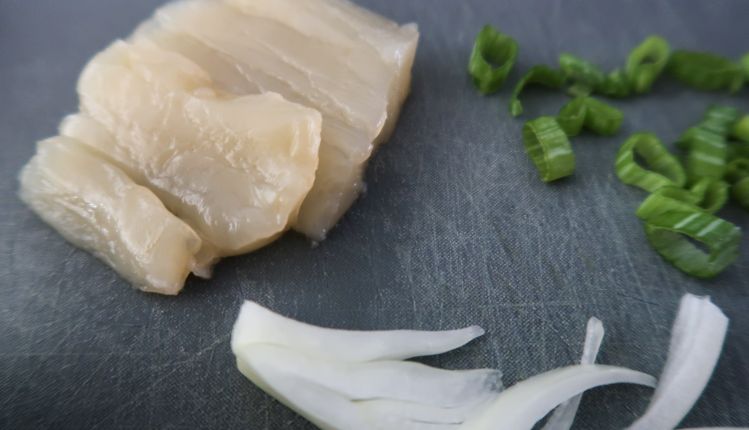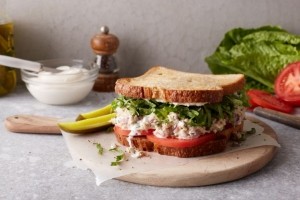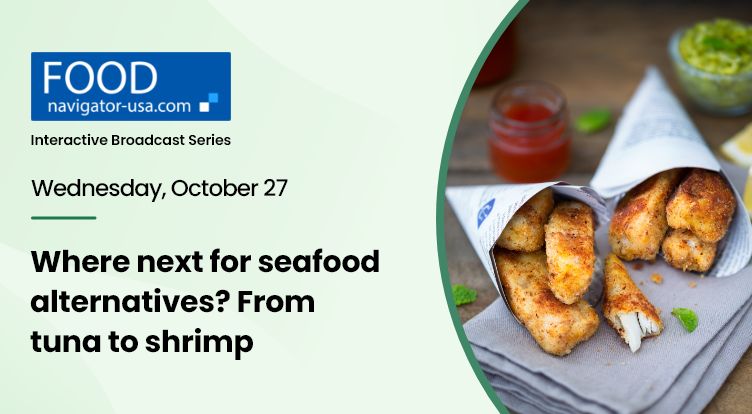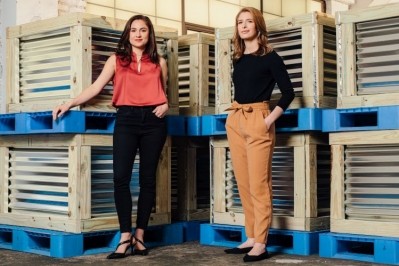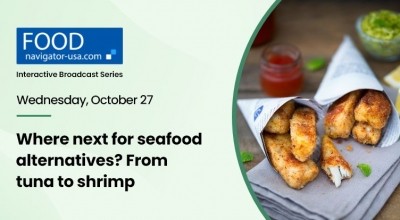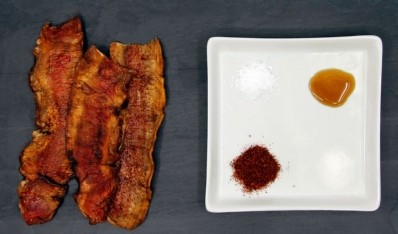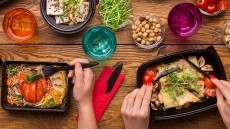Aqua Cultured Foods breaks new ground in alt-seafood space with fermentation-based whole cuts
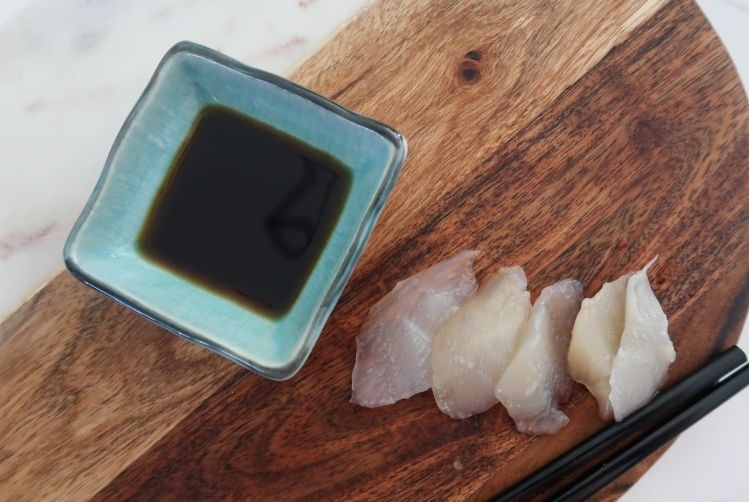
The Chicago-based company – which was founded last year by Anne Palermo and Brittany Chibe – has filed a series of patents (not yet public) covering the method of production, its usage in the food system, and the fungi strain itself, which they claim will open up new opportunities in a small, but fast-growing, seafood alternatives category currently dominated by soy, pea, and other legume-based protein extracts.
‘We're not messing with its DNA sequence or altering its genetic material because we want to maintain that non-GMO status’
Unlike synthetic biology companies genetically engineering microbes to express target proteins or other compounds, Aqua Cultured Foods has identified a strain of fungi that naturally grows into a fibrous biomass that can be harvested in its entirety as a Non-GMO, whole food ingredient.
Per serving, Aqua products will contain 18-20g protein, 10-12g fiber and no sodium, saturated fat or cholesterol, a range of B vitamins including B12 - and added omega-3s. (In comparison, a serving of cod contains 18g protein, 0.7g fat, nearly 43 mg cholesterol, 54 mg sodium, 0.19 grams of omega-3s, and no fiber).
“Fermentation was largely unexplored for growing seafood alternatives [right now, Quorn is the only player in this space with fungi-based fishless sticks], so we saw the opportunity to fill a white space in the market by creating a one-to-one replacement that’s realistic enough even for sashimi, nigiri and ceviche,” said Palermo.
“By nailing the taste, texture and nutritionals, we’ve developed something of a holy grail in the entire alternative protein space.”
Ingredient is tasteless: ‘We don't have to use any chemical masking agents’
Unlike many plant proteins which can present sensory challenges, Aqua Cultured Foods’ ingredient is “tasteless,” which is a “huge bonus,” Palermo told FoodNavigator-USA
“We don't have to use any chemical masking agents, so we have a very clean ingredient deck, we don't have to process the products and we have almost no sodium.”
As for fat, she said, “That has to be added. And that's part of our IP… how we're adding the fats to the whole cuts. We’re also adding omega-3s such as DHA to the breading in our breaded products.”
‘The exciting thing about the technology is that it's highly tunable’
Palermo – who has secured some pre-seed funding from Big Idea Ventures and Sustainable Food Ventures - added: “The exciting thing about the technology is that it's highly tunable, so we can change the texture and nutritional profile of final product by optimizing the feedstock and the environment.
“For example, calamari is a chewier product, so to create that kind of texture, the environment has to be one specific way, whereas for a lighter textured product, we might manipulate the humidity or temperature. The rate at which it grows also impacts the texture, so when we slow it down, it has a very different texture, which is just a part of the reason why this particular microorganism is so fascinating.”
But she added: “We're not messing with its DNA sequence or altering its genetic material because we want to maintain that non GMO status.”
While the initial focus is foodservice, there are also big opportunities in retailers’ refrigerated sets, she said.
“Where I think we're going to make the biggest splash is in the fresh refrigerated set. Because our products are whole cut, whole food products, they are able to withstand the temperature fluctuations, differences in humidity. Our products are not going to turn mushy in that refrigerated set like some products using protein isolates and starches that absorb water.”
‘The microorganism right now takes about 10 days to grow large ‘whole cut’ sheets, but we've already discovered ways to cut that growth time in half’
So how does Aqua Cultured Foods’ fungi strain grow? In solid state fermentation in shallow trays that look like Atlast Food Co’s mycelium-based meat? In liquid suspension in a bioreactor as per Meati Foods or The Better Meat Co?
Palermo can’t go into details on this owing to the patent application, but explained that, “It’s a little bit more like surface fermentation… as it matures, it rises to the surface, and it grows to the shape of its fermentation vessel, so some of our tests right now are around the shaping and the forming of the product.”
She added: “The microorganism right now takes about 10 days to grow large ‘whole cut’ sheets, but we've already discovered ways to cut that growth time in half, which is a very significant difference that we're really excited about.”
“I was growing mycelium on wet pieces of cardboard…’
Aqua Cultured Foods co-founder and CEO Anne Palermo cut her teeth in the food industry as a founder of better for you chocolate confectionery company Sulpice, but had been monitoring the alternative protein space for some time before co-founding a new company with Brittany Chibe in 2020.
“I've been in the food and beverage industry for about 10 years and in that time I've done food tech, food science, culinary innovation, and I've been watching what's going on with the alternative protein scene for some time. I started to do more research on sustainability, particularly looking at what's going on in our oceans and how are we going to feed the next two billion mouths, and it’s scary.
“My main focus at first was to create a protein, I was growing mycelium on wet pieces of cardboard, and as I started to recognize the potential of this particular microorganism, I started to realize its potential in seafood.”
Labeling and regulation: ‘We're working with a GRAS attorney’
Asked about the regulatory path forward for Palermo’s fungi-fueled whole cut seafood alternatives, she said, “We're working with a GRAS attorney to make sure we have all of our bases covered.
“But the really exciting thing is that this microorganism has been in the food system for thousands of years, so we should get that pre-1958 exemption [she claims a history of safe use has been established prior to 1958, such that the ingredient could be considered generally recognized as safe].”
As for how it would be listed on the ingredients declaration in the US, she said, “We’re talking with an attorney on that as well.”
When it comes to the business model, said Palermo, who is currently working to close a new funding round, “We're having a lot of unsolicited inbound interest from multinational companies interested in the b2b side, but our initial focus is going to be creating a consumer brand, being the household name for whole cut seafood, and then as we as we grow, then develop consumer partnerships.”
Scale it Up! Innovation Challenge
On the manufacturing front, the plan is to make the biomass ingredient in-house to safeguard the company's IP, but outsource the process of turning it into finished food products to co-packers, said Palermo.
“We were really fortunate to be of the startups [selected to participate] in the Scale It Up! Innovation Challenge run by Bühler, Cargill, Givaudan and Puris, so we’re getting a lot of assistance when it comes to R&D lab space and other support.”
The market for seafood alternatives
While fish is considered to be healthier than, say, burgers and sausages, the laundry list of problems linked to seafood - from overfishing to heavy metal contaminants, pollution, microplastics, PCBs, pesticides, antibiotics, fraud, mislabeling, illegal labor practices, habitat damage, and bycatch – is driving interest in greener, cleaner, and kinder alternatives, says the Good Food Institute, which promotes plant-based, fermentation-based, and cell-cultured alternatives to animal products.
And although plant-based seafood accounted for just $12m in US retail sales in measured channels in 2020 according to data from SPINS and IRI, many players believe seafood represents a significant untapped opportunity in a sector dominated by beef, pork and chicken alternatives, said the GFI in a recent report noting that there are now at least 85 players (that we know of) worldwide making seafood from plants, from microbes through fermentation, and from animal cells.
Good Catch recently opened a new plant in Ohio and entered into a joint venture with seafood company Bumble Bee Food; New Wave Foods has secured investment from Tyson Foods; Atlantic Natural Foods is seeing solid growth in its TUNO canned tuna alternatives; Nestlé has entered the market in Europe with ‘Vuna,’ a tuna alternative; Sophie's Kitchen just raised $5.6m; and Impossible Foods has plant-based seafood products in the pipeline.
Birds Eye’s Green Cuisine, added plant-based fish fingers in the UK; Seara Alimentos, a subsidiary of the Brazilian meat company JBS, has launched a line of plant-based products including fish sticks and cod in Brazil; Cargill has introduced a plant-based scallop co-branded with Japan-based c-store chain Lawson; Thai seafood firm Thai Union plans to introduce plant-based shrimp by the end of this year; and the Van Cleve Seafood Company has a plant-based spinoff called The Plant Based Seafood Co (previously Wild Skinny Clean).
Interested in seafood alternatives?
Join Anne from Aqua Cultured Foods, Chad Sarno at Good Catch, Michelle Wolf at New Wave Foods, Marika Azoff from the Good Food Institute, and David Benzanquen at Mission Plant on October 27 in our webinar, Where next for seafood alternatives? (part three of FoodNavigator-USA’s October broadcast series), to explore where the market is going next.
